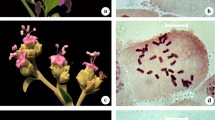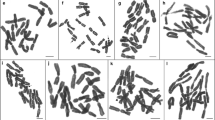Abstract
Five species (14 ecotypes) belonging to three subgenera of ornamental-medicinal Iranian Fritillaria plant were chromosomally and karyotypically assessed, using squash technique and 1 % (w/v) aceto-orcein stain. All species were diploid (2n = 2x = 24) having mean chromosome length of 16.8 μm (14.2–18.6 μm). The satellites varied in number (1–4 pairs) and in size (1.27–3.01 μm): mostly locating on long arms. Four chromosome types (“m”, “sm”, “st”, “T”) formed 11 different karyotypic formulas: the latter is being reported for the first time in some ecotypes in either S1 or S4. Nine chromosomal parameters were calculated. ANOVA verified intra- and inter-specific chromosomal variation in examined Iranian Fritillaria species. Twelve different methods were used to assess the degree of karyotype asymmetry. Among those, one qualitative (Stebbins classification) and seven quantitative (TF %, CVTL, DI, AsK %, A2, Rec, CG %) parameters verified that S2 and S5 species were recognized as having the most asymmetrical and symmetrical karyotypes, respectively.






Similar content being viewed by others
References
Arano H (1963) Cytological studies in subfamily Carduoideae (Compositae) of Japan. IX Bot Mag 76:32
Chen X, Boufford D (2000) Flora of China, vol 24. Science press, Beijing
Darlington CD (1937) Recent advances in cytology. Recent advances in cytology, 2nd edn
Das AK, Cohen PT, Barford D (1998) The structure of the tetratricopeptide repeats of protein phosphatase 5: implications for TPR-mediated protein–protein interactions. EMBO J 17(5):1192–1199
De Hertogh A, Le Nard M (1993) Physiological and biochemical aspects of flower bulbs. In: De Hertogh, Le Nard M (eds) The physiology of flower bulbs A. Elsevier Science Publishers, Amsterdam, pp 53–69
Erika L, Rebecca F (2005) “Fritillaria.” Gale Encyclopedia of Alternative Medicine, Encyclopedia.com. 15 May 2013
Fedorov A (1969) Chromosome numbers of flowering plants Acad. Sci USSR, Leningrad (now St Petersburg)
Gao Y, Zhou S, He X (2009) Karyotype of four genera in Liliaceae (s. str.) from Hengduan Mountains of Southwest China. Acta Botanica Yunnancia 31:399–405
Greilhuber J, Speta F (1978) Quantitative analyses of C-banded karyotypes, and systematics in the cultivated species of the Scilla siberica group (Liliaceae). Plant Syst Evol 129(1–2):63–109
Huziwara Y (1962) Karyotype analysis in some genera of Compositae. VIII. Further studies on the chromosomes of Aster. Am J Bot 49:116–119
Jolliffe IT (1986) Principal component analysis, vol 487. Springer-Verlag, New York
Karimzadeh G, Mousavi SH, Jafarkhani-Kermani M, Jalali-Javaran M (2010) Karyological and nuclear DNA variation in Iranian endemic muskmelon (Cucumis melo var. inodorus). Cytologia Int J Cytol 75(4):451–461
Karimzadeh G, Danesh-Gilevaei M, Aghaalikhani M (2011) Karyotypic and nuclear DNA variations in Lathyrus sativus (Fabaceae). Caryologia 64(1):42
Khaniki GB (2002a) Chromosome number of Fritillaria subgenera Petilium and Theresia (Liliaceae). Nucleus 45(1–2):6–11
Khaniki GB (2002b) Chromosome number of all Iranian species of Fritillaria caucasica group (Liliaceae). Nucleus 45(3):103–108
Khaniki G (2005) Giemsa C-banding studies on interphase nuclei of Iranian species of Fritillaria and Rhinopetalum (Liliaceae). Proc Nat Acad Sci India Sec B 75(4):294
Lavania U, Srivastava S (1999) Quantitative delineation of karyotype variation in Papaver as a measure of phylogenetic differentiation and origin. Curr Sci 77:429–435
Levan A, Fredga K, Sandberg AA (1964) Nomenclature for centromeric position on chromosomes. Hereditas 52(2):201–220
Li R, Shang Z (1989) The chromosome observation on five species of rare plants of China. J Wuhan Bot Res 7:217–220
Marchant C, Macfarlane R (1980) Chromosome polymorphism in triploid populations of Fritillaria lanceolata Pursh (Liliaceae) in California. Bot J Linn Soc 81(2):135–154
Metin Ö, Türktaş M, Aslay M, Kaya E (2013) Evaluation of the genetic relationship between Fritillaria species from Turkey’s flora using fluorescent-based AFLP. Turkish J Biol 37:273–279
Mozaffarian V (1992) New species and interesting plant records from Iran. Iranian J Bot 5(2):83–90
Naranjo CA, Ferrari MR, Palermo AM, Poggio L (1998) Karyotype, DNA content and meiotic behaviour in five South American species of Vicia (Fabaceae). Ann Bot 82(6):757–764
Noda S (1964) Cytology in the genus Fritillaria. I. Variations in karyotypes and B-chromosomes in F. amabilis. Bull Osaka Gakuin Univ 2:125–132
Paszko B (2006) A critical review and a new proposal of karyotype asymmetry indices. Plant Syst Evol 258(1–2):39–48
Peruzzi L, Eroglu H (2013) Karyotype asymmetry: again, how to measure and what to measure? Comp Cytogenet 7(1):1–9
Peruzzi L, Leitch I, Caparelli K (2009) Chromosome diversity and evolution in Liliaceae. Ann Bot 103(3):459–475
Rechinger KH (1990) Fritillaria L. In: Rechinger KH (ed) Flora Iranica, vol 165. Akad. Druck und Verlagsanstalt, Graz, pp 61–76
Rix E (1977) Fritillaria L. (Liliaceae) in Iran. Iran J Bot 1(2):75–95
Rix M, Frank E, Webster G (2001) Fritillaria: a revised classification: together with an updated list of Species. Fritillaria group of the alpine garden society
Roh MS (1993) Second International Symposium on the Development of New Floricultural Crops: Baltimore, Maryland, USA, Sep 15-21, 1991, vol 337. ISHS, International Society for Horticultural Science
Romero-Zarco C (1986) A new method for estimating karyotype asymmetry. Taxon 35:526–530
Rønsted N, Law S, Thornton H, Fay MF, Chase MW (2005) Molecular phylogenetic evidence for the monophyly of Fritillaria and Lilium (Liliaceae; Liliales) and the infrageneric classification of Fritillaria. Mol Phylogenet Evol 35:509–527
Stebbins GL (1971) Chromosomal evolution in higher plants. Chromosomal evolution in higher plants. Edward Arnold Publisher, London, p 216
Turktas M, Aslay M, Kaya E, Ertugrul F (2012) Molecular characterization of phylogeneticrelationships in Fritillaria species inferred from chloroplast trnL-trnF sequences. Turk J Biol 36:552–560
Vedatulug B, Korkut A, Sisman E, Muratozyavuz (2010) Research on propagation methods of Persian lily Bulbs [Fritillaria persica Linn.] with various Vegetative techniques. Pak J Bot 42(4):2785–2792
Wang S, Gao W, Chen H, Xiao P (2006) Studies on the morphological, thermal and crystalline properties of starches separated from medicinal plants. J Food Eng 76(3):420–426
Watanabe K, Yahara T, Denda T, Kosuge K (1999) Chromosomal evolution in the genus Brachyscome (Asteraceae, Astereae): statistical tests regarding correlation between changes in karyotype and habit using phylogenetic information. J Plant Res 112(2):145–161
Zencirkiran M, Gürbüz İB (2009) Turkish ornamental plants sector in the European Union screening process. J Fruit Ornam Plant Res 17(2):235–250
Zhang D, Sha J, Wang X (1992) Karyotypes of the genus Fritillaria from south Anhui. Acta Phytotaxonomica Sinica 30:62–69
Acknowledgments
The authors would like to thank Mr. Khourang and Mr. Asgari for their assistance. We are grateful to Tarbiat Modares University for financial support of this research project.
Author information
Authors and Affiliations
Corresponding author
Rights and permissions
About this article
Cite this article
Jafari, H., Babaei, A., Karimzadeh, G. et al. Cytogenetic study on some Fritillaria species of Iran. Plant Syst Evol 300, 1373–1383 (2014). https://doi.org/10.1007/s00606-013-0968-6
Received:
Accepted:
Published:
Issue Date:
DOI: https://doi.org/10.1007/s00606-013-0968-6




